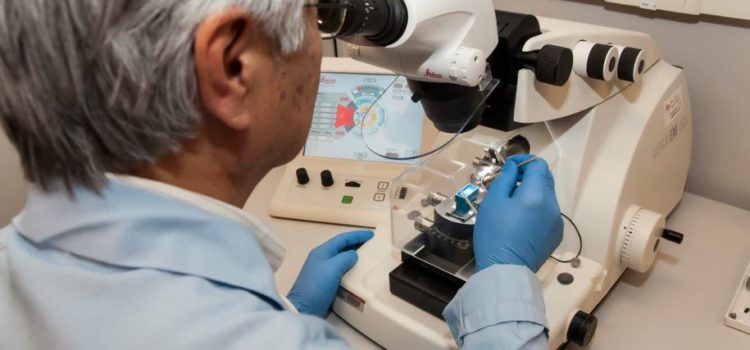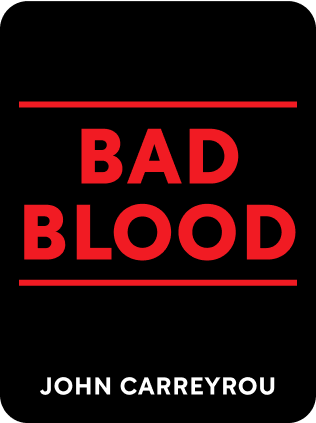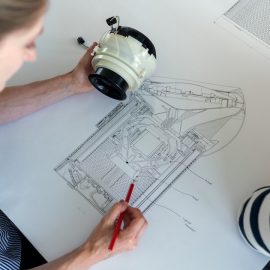

This article is an excerpt from the Shortform book guide to "Bad Blood" by John Carreyrou. Shortform has the world's best summaries and analyses of books you should be reading.
Like this article? Sign up for a free trial here .
What was the Theranos fraud? How did the company defraud investors and the public?
The Theranos fraud began with a business idea. Founder Elizabeth Holmes patented a product that performed blood work using blood from a finger prick. However, the product never existed.
Keep reading to find out more about the Theranos fraud.
Theranos Fraud Started With Elizabeth Holmes
Elizabeth Holmes practiced charismatic techniques to win over supporters and encourage the Theranos fraud.
- Elizabeth spoke sincerely and enthusiastically about the mission. It gave the impression that there was no way someone with this sincerity could be beguiling.
- To the Walgreens CFO, Elizabeth gave a gift of an American flag “flown over Afghanistan” with a dedication to Walgreens written on it.
- Many people repeated: “she had this intense way of looking at you while she spoke that made you believe in her and want to follow her.” Here’s an example of Holmes speaking in a Theranos promotional video.
- She apparently affected her voice to be a strikingly low baritone, possibly convinced it would lead to better results in a male-dominated world.
Stakeholders used pattern matching to jump to wrong conclusions.
- On paper, the technology fit the pattern of disruption – dramatically lower cost replacing the dinosaur incumbents, leading to massive adoption and market expansion. The story was intoxicating and irresistible. This indirectly encouraged Theranos fraud.
- Holmes looked like the stereotypical genius dropout founder. She even deliberately cast a resemblance to Steve Jobs with black turtlenecks.
- They crafted a cohesive narrative. From childhood, Elizabeth had a phobia of needles that led to the breakthrough technology.
To hide the fact that their proprietary machine that didn’t work, Theranos crossed the limits of scientific legitimacy. These were non-standard distortions of scientific practice.
- Theranos’s pitch was they could diagnose diseases on far less blood than normal blood draws. But it didn’t actually work. To process microliters of blood on standard third-party machines, they had to dilute the blood sample to have enough sample to read. However, this lowered the analyte concentrations below what the machines were qualified to handle, below their sensitivity and causing distorted results.
- In coefficient of variation studies (a measure of precision and repeatability), deviant results were repeated until they got satisfactory results – basically retaking a test until you get the right answers. Furthermore, they used only the median values of 6 replicates, guaranteeing a tighter CV.
- In quality control checks, outliers were inappropriately thrown out – basically changing the answer to get what you want.
- In sensitivity tests for syphilis, results that fell into an “equivocal zone” weren’t included in the calculations, letting Theranos widen the zone until sensitivity reached whatever number it wanted.
- When running proficiency testing for clinical lab accreditation, they ran the samples on third-party analyzers instead of their proprietary Edison machines. In other words, they were marketing the importance of their Edison machines to the public, while they actually ran samples on third-party machines. Their distorted logic to justify was that Edison’s technology was unique and had no peer group, so its results couldn’t be compared to the accrediting body’s machines.
When scientific manipulation wasn’t enough, Theranos’ fraud actively deceived people and lied by omission.
- To press and investors, Elizabeth embellished claims level of accuracy and number of assays that could be run on their proprietary machine.
- In truth, its accuracy was poor and it could run much fewer tests than claimed. They relied on third-party devices to run most of their assays, meaning Theranos was far less innovative than believed.
- Then, when regulators came to audit their operations, Theranos employees blocked investigators from accessing the room containing their new machines, misleading them into believing their third-party machines were the only ones operating. In fact, their faulty proprietary machines were inappropriately processing samples, when they weren’t improved to do so.
- Theranos was scheduled to run demonstrations for pharmaceutical company partners. When their devices didn’t work live, they ran fake demonstrations instead.
- Requests from a Walgreens employee to run validation tests on their machines were dismissed.
- The senior Walgreens management didn’t push back, because once they were committed to building out Theranos facilities, they desperately needed Theranos to work.
- Revenue projections to investors were vastly embellished by >5x.
- Outsiders had the impression that Theranos was flying high – that in a military partnership, Theranos devices were in the back of Humvees; that Theranos had plenty of secure partnerships with big name firms; that Theranos was cash flow positive. Naturally, Theranos didn’t care to correct them
When company insiders doubted the company’s strategy, Theranos actively quashed dissent, furthering Theranos fraud.
- Elizabeth said to employees, multiple times: “This is the most important thing humanity has ever built. If you don’t believe this is the case, you should leave now.”
- Non-believers were quickly fired for being disruptive, then bound by an NDA so they couldn’t leak details to press. Instead, sycophants and order-followers were promoted.
- Theranos retained a powerful legal team that dissuaded dissent, and made a public show of punishing former employees. For unhappy employees, it was easier not to fight the moral fight and just leave quietly.
- Former employees who were suspected of leaking bad information were threatened legally and monitored by private investigators.
- People in partnered companies with negative opinions (like a technology auditor at Walgreens) were removed from update calls for being disruptive to progress, further insulating executives at the partnering company from the truth.
Theranos actively kept information opaque, preventing the flow of information.
- Teams at Theranos were siloed in the name of security. Communication was stifled, and internet access was monitored.
- New devices and lab spaces were kept under heavy security. Many people never had a chance to look at the device’s innards.
- Departing employees were bound by NDAs. Visitors to the building were bound by NDAs.
- Only the best news were shared with team. Negative results were stifled.
Theranos explained away odd practices within the company and continued Theranos fraud.
- The heightened security and siloing were justified by the paranoia that Quest Diagnostics and Laboratory Corporation of America were actively undermining Theranos; by their supposed military work; and suggested that there was in fact something valuable to protect.
- Any negative press could be blamed on the incumbents trying to block their disruptor.
- People easily form their own conclusions, especially in support of their preexisting beliefs.
With all the above techniques suppressing doubt from leaking, Elizabeth continued her charisma and PR campaigns.
- In 2008, the board decided she was in over her head and wanted to replace her as CEO. She gave mea culpas, saying she promised to change and persuading them to step back. This never seemed to come up again.
- Her strength of conviction and sincerity likely made many people overlook shortcuts in pursuit of the larger goal.
Mental biases like fear of missing out and sunk cost fallacy prevented partners from looking deeper.
- Partner company Walgreens couldn’t pull out despite mounting doubts about Theranos. If the innovation were real, it couldn’t risk CVS taking it. Furthermore, it had already shouldered the money of the building out new clinics, and once it got deep enough, pulling out would have been intensely embarrassing.
- Because of all the hype, the investing rounds in Theranos were hot. Therefore, investors didn’t have the time to pause for deep due diligence. If they did express doubt and ask for more time, they’d likely be excluded from the deal.
Once something gains enough momentum, virtuous cycles can perpetuate the fraud for a long time.
- Once you have a critical mass of investors, press, and big-name supporters, it becomes easier to attract more of all, leading to further entrenchment of opinion
- First her professor Channing Robertson vouched for her, which got her early credibility. Then she got investor Donald Lucas on board; then she got statesman George Schultz on board. Each of these people opened doors to their own supporters, who heavily trusted their judgment. “If person X likes Theranos, then they’ve surely done their research, and I can trust their judgment.”
- Likewise, Rupert Murdoch invested big money after seeing Cox Enterprises and Walmart’s Waltons invest as well.
(Shortform note: To reject Theranos as a fraud meant rejecting every pillar of strength – 1) the investors, partners like Walgreens, AND its advisory board must not have done due diligence; 2) all the gushing press writers must have been hoodwinked; 3) government regulators must be ignoring the deception; 4) the data shown would have to be lies; 5) Elizabeth Holmes would have to be a psychopath
- It becomes easier to believe the naysayers must be wrong than to reject this entire monumental facade.
- What is less obvious to the person being deceived is that each card in the house of cards is built on each other; each pillar is not an independent vote of truth, but strongly dependent on what came before)

———End of Preview———
Like what you just read? Read the rest of the world's best book summary and analysis of John Carreyrou's "Bad Blood" at Shortform .
Here's what you'll find in our full Bad Blood summary :
- How a 19-year-old Stanford dropout created a fraudulent company that deceived savvy investors
- What Theranos claimed their proprietary technology could do
- How psychological biases could cause you to fall for such a deception






